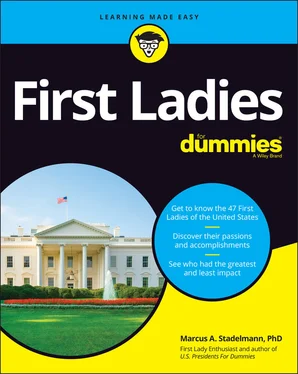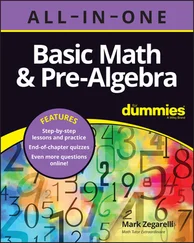Six out of nine first ladies during this time period pleaded ill health or grief as reasons for not being able to perform First Lady functions. They were Anna Harrison, Letitia Tyler, Margaret Taylor, Abigail Fillmore, Jane Pierce, and Eliza Johnson. Rachel Jackson had made arrangements for her niece to serve as First Lady in case she died, which she did. In some cases, there was no other way. Andrew Jackson’s wife passed right after he got elected president in 1828 and was unable to serve as First Lady. The same situation occurred in Martin Van Buren’s case. In both instances, younger nieces had to take over as First Lady.
Only two First Ladies were exceptions. Both Sarah Polk and Harriet Lane, the niece of President Buchanan who was a bachelor, were excited to become First Lady and were quite active. Not surprisingly, both are among my top ten most influential First Ladies (see Chapter 21).
The role of First Lady changed again after 1869. Suddenly, there were no more youthful surrogates being used as First Ladies. The new First Ladies came from different backgrounds compared to the First Ladies in Phase I. The ladies discussed in Part 4weren’t married to founding fathers nor were they the wives of rich plantation owners. However, they were well educated, and many came from small-town America.
The press started talking about the First Ladies reflecting the ideal of the new woman. The new woman was educated, as universities had opened up enrollment to women. The new woman was also involved in political organizations. The Civil War had gotten many women involved in public organizations, and all female political and social clubs were founded.
Many political and social barriers were broken down during this period. Some political gains happened, too. Women got the right to vote at the local and state level, and the country saw its first female politicians elected at the local level. Some women were even appointed to state and local government positions. By 1900, women could vote in four states: Wyoming, Idaho, Colorado, and Utah. Even though women still had to attach themselves to their husband’s career, many spoke out in public and created and joined national organizations. Not surprisingly, the suffrage movement gained steam, too, and by 1917, the first female member of Congress, Jeannette Rankin from Montana, was elected.
With the outbreak of WWI, the role of women and First Ladies changed yet again. After becoming a part of the war effort, women suddenly stayed a part of the workforce and in 1920 received the right to vote at the presidential level. Florence Harding was the first woman to cast a ballot for her husband in 1920. Right before, Edith Wilson basically became the president herself after Woodrow Wilson suffered a debilitating stroke. She became his guardian and gatekeeper and studied every paper and decided what would go to the president and what wouldn’t. In other words, she became responsible for policy making, and letters sent to her addressed her as “Mrs. President.”
In the 20th century, with wars and the second industrial revolution, the role of women dramatically changed in the U.S. This brought about a change in the role First Ladies performed and also changes in American culture. Here is where the modern era for First Ladies began. They became public figures pursuing their own causes, which made them not only more famous but also resulted in the media scrutinizing them even more. (Check out Part 5for these First Ladies.)
Then, after 1960, First Ladies’ roles changed rapidly one more time. For the first time, First Ladies started campaigning for their husbands, even on their own, which previously had been considered not proper. Today, First Ladies campaigning for their husbands hasn’t just been accepted but is expected. In addition, First Ladies today are expected to pick a public cause to focus on, which in turn gets them involved in political issues. They truly have become a first partner to today’s presidents. By now, First Ladies often outstrip their husbands in popularity, emotional access by the public, and even book sales.
In the beginning, First Ladies were mostly nonpartners in their husband’s presidencies, and today they have become full partners. They are now equal in not just social or charitable matters but also in political matters. From Edith Wilson to Eleanor Roosevelt to Hilary Clinton, First Ladies have become trusted allies and advisors for their husbands and have asserted themselves independently.
Today, many First Ladies are highly educated, have professional portfolios, and have ambition to seek political office. Traditionally, a First Lady’s background has impacted how influential and assertive she will be.
Educational achievement and professional experience are great predictors on how strong First Ladies will be. Based on this, it’s possible to predict that future First Ladies will be more independent, more politically involved, and possibly more controversial in the public’s eyes compared to the First Ladies of the past.
Chapter 2
First Lady Rankings and Evaluations
IN THIS CHAPTER
 Studying First Lady rankings
Studying First Lady rankings
 Looking at ten evaluation criteria
Looking at ten evaluation criteria
 Reviewing an academic survey
Reviewing an academic survey
This chapter looks at how experts rank U.S. First Ladies. The public is aware of some of the First Ladies, namely the wives of our most famous presidents. This knowledge comes mostly from schools and the emphasis that the media places on these important First Ladies. But when was the last time you read about or saw a show on Lucy Hayes or Grace Coolidge? On the other hand, you can choose among several movies or books about Eleanor Roosevelt or Jaqueline Kennedy.
Polls show that most U.S. citizens know about the First Ladies in office during their lifetime but don’t know much about the First Ladies of the past. Most Americans are familiar with Michelle Obama, Nancy Reagan, and even Jaqueline Kennedy. But what about Helen Taft or Sarah Polk? Therefore, the public ranks current and famous First Ladies higher than lesser-known first ladies. Academics who study First Ladies, on the other hand, have a better historical perspective and do rank some of our founding First Ladies, such as Abigail Adams and Dolley Madison, very high.
Over time, the standing of a First Lady may change within the rankings of the U.S. public and academics, providing for renewed interest in her life and actions while serving as First Lady. Some First Ladies are highly regarded after they leave office, only to end up being considered disappointments in the long run. Other First Ladies may be considered failures shortly after the end of their term and then become popular later. Nancy Reagan is a great example of this. When her husband left office in 1989, she was ranked very low, among the ten least influential First Ladies. This changed over time, as people took a look at what she had done and how influential she was with her husband, especially during his second term. By the time the newest rankings came out in 2014, she made it into the top 15 list of First Ladies.
This chapter looks at the one consistent academic survey of U.S. First Ladies, the Siena College Research Institute Survey on First Ladies, which is taken just about every decade.
Evaluating the First Ladies
Читать дальше

 Studying First Lady rankings
Studying First Lady rankings










